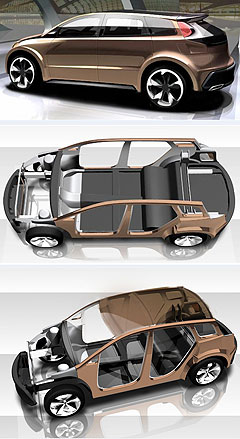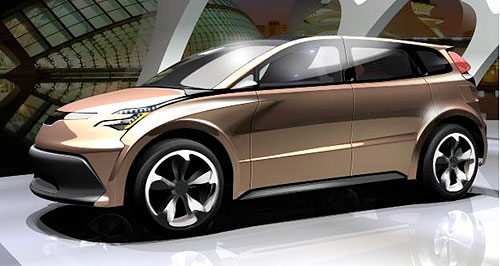Future models - LotusLotus sheds light on low-mass futureMass changes: Lotus Engineering put a Toyota Venza on a weight-loss program to cut its weight by a third. Lotus concept achieves massive reduction in vehicle mass, for minimal rise in cost30 Apr 2010 By TERRY MARTIN THE engineering arm of Proton-owned British sportscar manufacturer Lotus has developed an ultra-lightweight passenger vehicle concept which demonstrates that more than a third of vehicle mass can be reduced in mainstream cars for only a modest increase in cost. Using the Toyota Venza medium-sized crossover as its benchmark, Lotus Engineering has drawn on engineering techniques and technologies expected to be viable for mainstream production programs by 2020 to create a concept that shows “the lightweight future of the passenger car”. With a combination of lightweight materials and efficient design, Lotus claims to have achieved a 38 per cent reduction in vehicle mass, excluding the powertrain, for only a three per cent increase in component costs. In other words, the Venza’s 1290kg mass was reduced to just 800kg on the Lotus-engineered 2020 concept. The company’s findings were released this week by the International Council on Clean Transportation and show how significant reductions in fuel consumption and CO2 emissions can be achieved for a regular mass-market vehicle through means other than the powertrain. Using US Department of Energy estimates, Lotus claims that a 33 per cent reduction in total vehicle mass, including the powertrain – as achieved with its 2020 concept – results in a 23 per cent improvement in fuel economy.  Still committed to founder Colin Chapman’s ethos of “performance through light weight”, Lotus Engineering says the 2020 vehicle architecture uses a mix of stronger and lighter weight materials, a high degree of component integration and advanced joining and assembly techniques. Still committed to founder Colin Chapman’s ethos of “performance through light weight”, Lotus Engineering says the 2020 vehicle architecture uses a mix of stronger and lighter weight materials, a high degree of component integration and advanced joining and assembly techniques.It also produced a “near-term” 2017 prototype based on applying current advanced technologies, improved materials and component integration to the same vehicle, with assembly at existing facilities. In this application, Lotus claims to have achieved a 21 per cent reduction in mass for the Venza-based vehicle, with an estimated cost saving of two per cent. To create the two concepts, Lotus engineers disassembled, analysed and weighed the Venza to develop a “bill of materials” and to “understand component masses” before applying its mass-reduction strategy. Working in conjunction with the US Environmental Protection Agency and the National Highway Traffic Safety Administration, Lotus says it retained all key interior and exterior dimensions and volumes for both models. The vehicles were packaged to accommodate key safety and structural dimensional and quality targets, with the concepts also retaining the vision, sight line, comfort and occupant package of the Venza. Lotus Engineering’s North American CEO Darren Somerset said: “A highly efficient total vehicle system level architecture was achieved by developing well-integrated sub-systems and components, innovative use of materials and process, and the application of advanced analytical techniques. “Lotus Engineering is at the forefront of the automotive industry’s drive for the reduction in CO2 and other greenhouse gas emissions, and this study ... outlines a clear roadmap to cost-effective mass-efficient vehicle technologies.” Whereas the benchmark Venza’s body-in-white contained more than 400 parts, the 2020 model reduced that number to 211. Body materials in the Venza were 100 per cent steel, while the 2020 concept uses 37 per cent aluminium, 30 per cent magnesium, 21 per cent composites and seven per cent high-strength steel – which Lotus says reduces the structure mass by 42 per cent, from 382kg to 221kg. “Closures” and fenders across the vehicle’s exterior, which include hinged elements such as the doors and tailgate, were made of 100 per cent steel on the Venza, while Lotus dropped the steel content to 18 per cent and employed other materials including magnesium (33 per cent), plastic (21 per cent) and aluminium (six per cent). In doing so, Lotus claims it achieved mass savings of 41 per cent, from 143kg to 84kg. A further reduction was achieved by replacing the steel beam in the front bumper with an aluminium one, which reduced mass by 11 per cent. Inside the vehicle, the 2020 car is said to have a higher degree of component integration and electronic interfaces over the Venza, which relies heavily on traditional mechanical controls. The instrument panel, for example, is replaced by individual driver and passenger modules that contain “all key functional and safety hardware”. A number of other conventional trim panels are also eliminated in favour of new designs made from lightweight materials such as aerated plastic. As well as controlling audio, temperature and navigation systems, the main touch-screen contains the gearshift and park-brake functions and interfaces with small electric solenoids, eliminating the need for conventional steel park-brake and shifter controls and cables. It also serves to free up cabin space. Traditional seat mounting brackets are made redundant with the seats mounted to the vehicle structure (saving 10kg), while composite materials reduce the seat mass by up to 50 per cent. Overall, the interior mass of the 2020 concept was 153kg, with projected cost savings of four per cent. The 2017 concept, meanwhile, achieved interior mass reduction from 250kg to 182kg, with projected cost savings of three per cent. With the chassis and suspension, the 2020 concept uses smaller components based on the lower kerb weight. The need to maintain the baseline cargo capacity (549kg), and the use of a hybrid drivetrain, was also factored in. Lotus claims to have reduced kerb weight by 38 per cent, excluding the powertrain, with the chassis and suspension components reduced in mass by 43 per cent. Projected cost savings in this area were five per cent. With electrical and lighting systems, Lotus says the use of “thin-wall” cladding and copper-clad aluminium wiring on the 2017 model reduced mass by 36 per cent compared to the Venza. “Lighter vehicles are cleaner and more efficient. That philosophy has always been core to Lotus’ approach to vehicle engineering and is now more relevant than ever,” said Lotus Engineering director Robert Hentschel. “We believe that this approach will be commonplace in the industry for the future design of vehicles.”  Read more6th of April 2010  Lotus chops pricesPrices slashed by up to a massive $18,500 on Lotus models from AprilAll future models Alfa Romeo Alfa Romeo Abarth Abarth Audi Audi Aston Martin Aston Martin BMW BMW Bentley Bentley Chrysler Chrysler Chevrolet Chevrolet Dodge Dodge Citroen Citroen Ferrari Ferrari DS DS Ford Ford Fiat Fiat FPV FPV Foton Foton Haval Haval Great Wall Great Wall Honda Honda Holden Holden Hyundai Hyundai HSV HSV Isuzu Isuzu Infiniti Infiniti Jeep Jeep Jaguar Jaguar Lamborghini Lamborghini Kia Kia Lexus Lexus Land Rover Land Rover Mazda Mazda Maserati Maserati Mercedes-Benz Mercedes-Benz McLaren McLaren Mini Mini Nissan Nissan Mitsubishi Mitsubishi Peugeot Peugeot Opel Opel Proton Proton Porsche Porsche Renault Renault Ram Ram Saab Saab Rolls-Royce Rolls-Royce Smart Smart Skoda Skoda Subaru Subaru SsangYong SsangYong Tesla Tesla Suzuki Suzuki Toyota Toyota Volvo VolvoMotor industry news |
Click to shareLotus modelsResearch Lotus All future models Alfa Romeo Alfa Romeo Abarth Abarth Audi Audi Aston Martin Aston Martin BMW BMW Bentley Bentley Chrysler Chrysler Chevrolet Chevrolet Dodge Dodge Citroen Citroen Ferrari Ferrari DS DS Ford Ford Fiat Fiat FPV FPV Foton Foton Haval Haval Great Wall Great Wall Honda Honda Holden Holden Hyundai Hyundai HSV HSV Isuzu Isuzu Infiniti Infiniti Jeep Jeep Jaguar Jaguar Lamborghini Lamborghini Kia Kia Lexus Lexus Land Rover Land Rover Mazda Mazda Maserati Maserati Mercedes-Benz Mercedes-Benz McLaren McLaren Mini Mini Nissan Nissan Mitsubishi Mitsubishi Peugeot Peugeot Opel Opel Proton Proton Porsche Porsche Renault Renault Ram Ram Saab Saab Rolls-Royce Rolls-Royce Smart Smart Skoda Skoda Subaru Subaru SsangYong SsangYong Tesla Tesla Suzuki Suzuki Toyota Toyota Volvo VolvoMotor industry news |
















Facebook Twitter Instagram